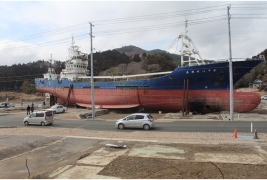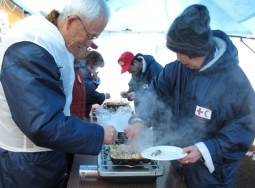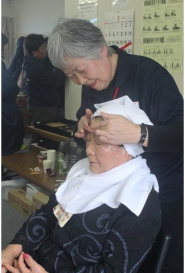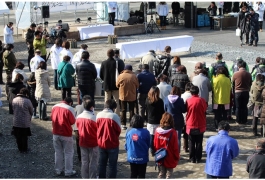Red Cross event at the temporary homes provides smiles on suvivors' faces
2012/03/13

Rebuilding Japan’s devastated north-eastern coastline has presented urban planners, municipal authorities and local townsfolk with a range of dilemmas which are taking time to reach consensus around. Over 300,000 people have been displaced from their homes and the sheer scale of destruction has brought into question the future sustainability of some communities but has also provoked criticism of the pace of reconstruction.
(Photo: A grounded fishing trawler has become an iconic symbol, left behind by the tsunami in Kesennuma town in Miyagi prefecture.)
While the government has built over 50,000 prefabricated homes, reconstruction of permanent houses has barely begun. In larger cities such as Ishinomaki in Myagi prefecture, many townsfolk are still living in the second storeys of their partially damaged homes whilst others are in temporary homes, unable to return to areas where the land itself has subsided by up to a metre due to the earthquake. A priority for most municipalities is to ensure that residents can sleep easy at night which means building homes for thousands of people on land which is well above sea-level, a challenging prospect that will require major costs to purchase the land and re-engineer the local topography.
In some places there is fierce opposition to government proposals to merge some communities. On a peninsula to the east of ishinomaki lie a series of small fishing hamlets where the tsunami first made landfall, half an hour after the earthquake struck. These once picturesque communities now lie in ruins but the local fishermen whose livelihoods depend on the area are adamant that they should be rebuilt as they were. But an investment in the infrastructure and services that each community requires, means that each hamlet should be viable and a sufficient number of people will want to return. Prior to the Tsunami, many of these coastal communities were home to a large ageing population and since the disaster many of the young have been forced to move elsewhere in search of work.

Perhaps one of the biggest anxieties that survivors face one year on from the disaster is the continuing uncertainty over their future and how long they will have to remain in temporary housing. 58 year old Kazuko Suzuki is still too afraid to return to where she used to live in Tagajo city in Miyagi.
“400 houses in my community have gone. I want to go back and lay some flowers for my grandfather who died but I don’t have the courage to go back”.
She barely managed to escape with her life and the memories of the tsunami still haunt her.
“I still remember the faces of an elderly woman and her daughter who were trapped in their car. We saw them from the roof of the evacuation centre and couldn’t do anything as they were swept away”, she says.

Kazuko now lives in a prefabricated home with her husband barely 15 minutes from her former home. She wants to start her life again away from the sea. Twice a month, a team of Japanese Red Cross volunteers visits the 50 households in the community where she lives to run a programme of social activities largely targeted at the elderly residents. The day starts with the volunteers cooking Takoyaki balls, made from octopus, flour, onion, egg and shrimp. As the residents gather in the community centre they are offered massages, manicures and facials and a Red Cross nurse takes their blood pressure and runs health checks.
(Photo:Kiyoko Sato, a Japanese Red Cross volunteer gives a facial to an elderly resident of the Tagajo temporary housing centre as part of the Red Cross psychosocial support programme for tsunami survivors.)

Part of the volunteers training is to facilitate conversation amongst the residents. “We are trying to contribute to the formation of the community, bringing people together like this gives them the opportunity to talk and get to know each other”, explains Kazuko Fukuda, the nurse attached to the volunteer group.
Over the anniversary period the constant stream of programmes on Japanese TV looking back at the tsunami are bringing back painful memories and increasing stress levels amongst survivors. Nurse Fukuda clutches the hand of Kazuko Suzuki as she bursts into tears while recounting how her grandfather was left behind. “He did so much for me. I saw the door of his house closed and thought he’d escaped, but he was still inside”.
Kiyoko Sato has worked for ten years as a volunteer with the Myagi chapter. “Some people escaped from their homes with nothing. They might sit down and say nothing as I give them a facial. But when I ask them if they want some colour on their lips and they look in the mirror at the result, they just light up and we start chatting. It’s the simple things that can make a big difference”.
(Photo: Residents of Kesennuma bow their heads during the minute’s silence on March 11th to remember those who died in the 2011 tsunami.)















